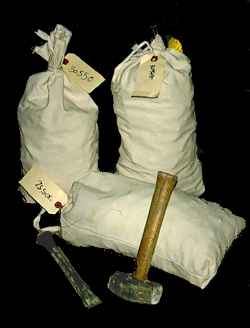  When a measured section has been made, rock and fossil
samples can be located according to the precise bed from which they were taken.
Location according to bed is important, as it expresses the age of a sample relative
to other samples from the site. Each sample is given a unique number that is marked
on the specimen or sample bag and also recorded in the notes or graphic plot for the
measured section.
When a measured section has been made, rock and fossil
samples can be located according to the precise bed from which they were taken.
Location according to bed is important, as it expresses the age of a sample relative
to other samples from the site. Each sample is given a unique number that is marked
on the specimen or sample bag and also recorded in the notes or graphic plot for the
measured section.
 Normally a geologist will take representative samples of all of the different kinds of rocks
and fossils encountered in a measured section. Actual sampling schemes vary widely.
A geologist interested in ecology of reefs may sample hundreds or thousands of fossils
for statistical analysis. A geologist interested in microscopic properties of sedimentary
rock may take only small "hand samples" from beds. Normally a geologist will take representative samples of all of the different kinds of rocks
and fossils encountered in a measured section. Actual sampling schemes vary widely.
A geologist interested in ecology of reefs may sample hundreds or thousands of fossils
for statistical analysis. A geologist interested in microscopic properties of sedimentary
rock may take only small "hand samples" from beds.
|


